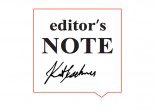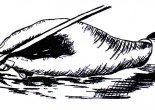Whipping Boy
Marty York is a hard-nosed reporter in a World of sports scribes. Is that what makes him so hated?
Marty York sits alone at the front of the plane. There are 35 players, coaches and other writers on board, but they shy away from him. While York displays no anger, his helpless expression reflects hurt and frustration. He looks like a misfit kid being picked on at recess only the bullies in this case are the highly paid members of the Toronto Blue Jays. On the field they are heroes who make hitting and throwing an art form. Here they just throw garbage. First, a few peanuts fly toward York’s head from five rows back. Then a barrage of more peanuts, rolled-up socks, odd bits of airplane food. Seeking an ally, York turns to one of the other writers. “What’s going on?” he asks. He doesn’t know why they are doing this to him. He can’t understand what he’s done to deserve it.
Some five years after the incident, York is still wondering. His airborne humiliation is typical of the hostility he encounters almost everywhere he goes. A Globe and Mail columnist who’s built a reputation for harsh, critical reporting, York is despised not only by most of the sports personalities he covers but by most of his colleagues in the press box as well. In the cozy little world of sports heroes and scribes, he is an outcast-and he honestly doesn’t know why.
I wanted to find out. Reading his copy didn’t explain it. In print, he’s fearlessly tough, especially on the pampered Blue Jays. If, as his accusers say, his copy sucks, it doesn’t suck up to anything or anybody. He’s no PR man for the franchise, but an for fans, though many are sick of his relentless faultfinding. Though his judgment ( be questioned and his predictions wrong, he covers sports like a legislative reporter covers government, as a watchdog. He doesn’t run with t pack, rather he breaks big stories by chasing and that colleagues are afraid to touch. Yet he’s at t top of every sports department’s hate list-including the Globe’s Why?
I had my own reasons for asking. As a writer fascinated by pro sports since childhood wanted to discover the real workings of a profession I hoped soon to enter. I had imagined a happy little fraternity, but soon discovered a fractioned gang consumed by competition, jealousy or hate. They were playing a bitter game and Marty York seemed to be their pawn. Was he being vilified simply for reporting big-time athletes the way he sees them, rather than the way they want to b seen? If a guy like him, 18 years on the job, damned for applying normal journalistic standards to coveting his beat, what chance is there for a novice like me to do serious work?
I figured there had to be deeper reasons for York’s outcast status. What did you have to do to be the target of crank calls and endless mocking remarks? To have colleagues on your own paper demanding that you be fired? To have a 225 pound baseball player threaten to use you for batting practice?
I had heard some rumours, but was unprepared for the level of anger and contempt I tapped into as I canvassed sportswriters across the country. Few of them, especially the writers on his own paper, would speak for attribution. But once granted anonymity, they had all kinds of stories, interesting and hilarious, varying in credibility. I’m a little shamefaced to admit that I began to enjoy swapping some of them.
“Did you hear about the time when Marty was afraid to go down to the dressing room so he paid some flunky a hundred bucks to run quotes for him at the 1989 Grey Cup?”
No kidding?
“What about the time the reporter went into the clubhouse and one of the athletes mistook him for Marty, grabbed him and was threatening to beat the shit out of him? And here was this poor guy with his hand in front of his face pleading, ‘I’m not Marty York, I’m not Marty York.'”
A lot of York bashing went like that, juicy items from the gossip circuit. But just as much of it was deadly serious, especially when it came from York’s colleagues at the Globe. “I don’t think we should be running his stuff because it’s not good enough,” said one writer. “Never mind everything else, it’s not good enough to run in The Globe and Mail.” The contempt in that comment was shocking enough, but it was the “everything else” he alluded to that interested me more. What, besides sweeping value judgments, was behind the slagging of Marty York?
To get some answers I called a bunch of guys in the sports department at The Toronto Star, where dislike for York is no secret. What I got instead was a hostile brush-off. Rick Matsumoto refused to go on record, Mark Zwolinski wanted nothing to do with the subject, Jim Proudfoot suggested I talk to York’s pastor and grade-school teacher if I wanted to do a profile, and Dave Perkins told me to take my business elsewhere.
Though intimidated by their surliness, I kept up the calls and slowly, among those who would talk, the rap against York began to emerge. He was accused of sensationalism, one-sided reporting, and-most gravely-plagiarism. Not incidentally, there was also much talk of his salary, $80,000 to $100,000 a year, which makes him one of the highest paid newspaper writers in the country.
To many in the business, then, York’s columns are an expensive waste of space in the already diminished sports pages of The Globe and Mail. “Sports journalism has always been thought of as second-rate,” says one Globe writer. “What we need is someone out there doing great reporting, not someone who seems to be cutting all the comers. It’s bad for business, no doubt about it.”
Not as far as York’s supporters are concerned-and he does have them. “Marty is a terrific reporter,” says Earl McRae, the gutsy and outspoken columnist for the Ottawa Sun. “He’s often maligned for the wrong reasons. A lot of it is simple jealousy.” And, he adds, York also suffers because he works outside the pack, asking the tough questions while others cheerlead for the home team.
But whether you talk to those who defend Marty York or those who denounce him, the fact remains that he is the centre of a hellish controversy. And as I prepared for my first interview with him I was expecting to meet with the journalistic version of the devil himself.
The character before me looks nothing like his column photo, nor anything like the monster I had let my careless imagination create. Hidden behind his wire rimmed glasses, he is smaller, less intimidating, with a quick laugh that adds to his boyish appeal.
In conversation, he comes across as soft-spoken and insecure, and distinctly troubled by the animosity he attracts. “Maybe there are flaws in my character that I don’t know about that have bred this contempt towards me,” he says. “I try to get along with everyone. I really like them [his Globe colleagues]. I just don’t know if they like me. Maybe it’s some personality flaw or maybe they resent my style, my salary .”
York’s main work base is an office in his home, in an affluent neighbourhood in Thornhill, Ontario, miles from the scorn and pressures of the Globe newsroom in downtown Toronto. He works at a large, uncluttered desk that leaves little space for other furniture. On the desk are two telephones sitting side by side, his lifeline to his sources. There are signs of York’ s insecurity in several aspects of our meeting. He insists on keeping his own tape recording of our talk, explaining, unconvincingly, that it’s purely for backup. On the wall behind his desk is a badly creased letter Scotch-taped to the wall. It’s a letter of praise that Joe Falls, sports editor of The Detroit News, wrote to Globe management: “I know of no sportswriter in the U.S. or Canada who is displaying more energy, enterprise and enthusiasm than Marty York” As I glance at the letter, York walks up behind me smiling, almost urging me to use parts of it. “Please Anthony, feel free to use anything you want.”
As I spend more time with York I find myself involved in a continuous mind game with him-a game that could be called Guess My Weaknesses. It begins with York asking me who else I’ve talked to, what did they say and was it for attribution? “Did you find anyone at all who had something good to say about me ?” he asks, then, after a quick chuckle, adds, “No, seriously, Anthony, I do have friends in the business.”
When I try to ignore his questions he even begins asking whether I’ve talked to reporters with certain initials that he lists. Then, more bluntly: “Did you talk to Dave Perkins, Pat Hickey?” I admit talking to Hickey, associate sports editor and columnist for The Gazette in Montreal. York snaps back: “None of the stuff Hickey told you ” was true.
The game is over. Ironically, Hickey is one of the people who speaks kindly of York. In fact, according to Hickey and several other sportswriters, York has natural reporting talent. But his insecurities sometimes lead him to betray it. “Marty worries too much about what other people are saying about him,” says one Globe writer. “He gets upset if he hears someone is saying something unkind about him and, to avoid this, he tries to get stories that other people don’t have. If it means getting those stories by means that are sometimes unethical, i.e. borrowing them off someone else, then he does that. It all stems back to his basic insecurities.
In the past three years York has been accused of plagiarizing from three publications, most recently The Gazette in Montreal. On February 27, 1991, Gazette writer Michael Farber wrote the following about an outfielder newly acquired by the Montreal Expos:
Ivan Calderon sauntered into the Expos’ clubhouse yesterday decked out in two 10pound gold chains around his neck, a diamond bracelet that spelled I-V -A-N on his right wrist, a Rolex watch on his left wrist and a No. 22 diamond earring on his left ear.
Calderon wears your mortgage.
“The chains were $7,000 each,” said Calderon, removing one and handing it to a man who hadn’t lifted anything that heavy since letting his Nautilus club membership expire. “The bracelet was $2,000. The watch was $6,000.”
And the earring? “The guy gave it to me for free.”
A week later, this description of Calderon appeared in York’s column: He wears two 10-pound gold chains around his neck, a diamond bracelet that spells IVAN on one wrist, a Rolex watch on his other wrist and a diamond earring in his left ear. The chains are worth $7,000 (U.S.) each. The watch goes for $6,000. The bracelet, $2,000. The earring, $1 ,000.
Someone cracked that Calderon wears your mortgage.
I am driving with York in his car in downtown Toronto when I ask if he can explain the similarities between these two columns. Gone is the joking and laughing that flowed so naturally in the hours before. York is in a drastically different mood, late for an appointment, nervously scratching his leg and clenching the steering wheel tightly as he searches for his destination and for an answer to my question. He is lost. “I’ve already explained that to the people that need those explanations, and they were satisfied,” he says. “They understand there was no plagiarism at all, and I don’t think it does me any good to talk about it any further.”
Globe management questioned York c the issue in Aptil 1991. “Some duplicate of copy was presented to me and I took it to the managing editor, and after a discussion with Marty it was resolved to our satisfaction,” says Globe sports editor David Langford. Was plagiarism committed? Langford will only say: “There were some issues that we had to discuss with Marty and we deal with it in a private manner and that’s the way it will stay.”
Globe sources say York was given warning. But many believe he should had been fired. “It’s a worse incident than I’ve seen people fired for in the past. Judging r the responses of people at the Globe, tt decision reached by management was sin ply not valid,” says one Globe writer. “I t’ s a embarrassment to the paper and an embarrassment to them.”
The charges of plagiarism against Yor were actually researched and brought t Globe management by other reporters at th paper. “If they want to embarrass me, IE them go ahead,” says York. “I don’t thin they’ve done anything to spoil my goo name.”
This issue aside, York has allegedly done some other things himself to spoil his good name. He’s often accused by athletes of misquoting them. The Blue Jays’ dressing room is now foreign territory; many player there refuse to talk to him. “You wonder why it is that on every occasion Marty breaks a story that involves a player’s quote that they always say they have been misquoted,” says one Globe writer. “I can’ remember the last time anybody, after the shit hit the fan, came to me and said the~ were misquoted.”
York dismisses the charge of misquoting, redirecting the heat at the players “They’ll say something and then they’ll realize ohhh God what did I say, and sometimes they’ll get a lot of heat for it. So the easiest thing for them to do is just deny it.”
York was embroiled in a controversy after a column appeared last August in which he insinuated that there were racist divisions among players on the Montreal Expos. He quoted second baseman Delino DeShields, one of the two black starters on the Expos, as saying, “Yeah, it’s just me and Marquis these days, that’s all.”
It was a big story, at least in what it implied. “Marty took that to mean that the clubhouse was clique ridden and racially split,” says Jeff Blair, a baseball writer for The Gazette. “The Expos have had a lot of problems in the past three years, but the one thing they have not had is racial problems.” Blair says that, in his comment to York, DeShields was really only suggesting that centre fielder Marquis Grissom was the last player left in an old gang of friends who had since left the team.
As I spoke more to York about this kind of issue, I did come to see him not simply as an insecure man despised for unethical conduct, but also as something of a maverick fighting the system. “Telling somebody something they don’t know is my number one objective,” he says. “I don’t care if it’s positive or negative as long as it’s newsworthy, interesting and entertaining.”
It’s a simple and obvious credo, but one not followed by many sportswriters these days. Most newspaper sports reporting goes no further than asking a player “How’s the knee!” and serving up the answer along with last night’s scores and a cliche or two for colour. “It’s PR bullshit,” says McRae. “It’s disco journalism, it’s glib and it’s cozy.” Whatever else you can say about Marty York, you can’t say he’s ever found his own cozy place in sports journalism. And that’s to his credit. Since joining the Globe in 1974, he’s always fought to go his own way. His first Globe job was covering high school sports under the guidance of former managing editor Clark Davey and the late sports editor Jim Vipond. Though only 16 when he started, York broke several big stories. The biggest initiated an investigation into the illegal recruitment of basketball players by a downtown high school.
While studying political science and history at York University, he continued to work part-time for the Globe, dividing his time between sports and news. When he graduated, in 1978, York joined the paper full-time in sports. He soon found himself on the receiving end of a lot of criticism from other staffers.
Paul Palango, sports editor at the Globe from 1983 to ’86, recalls his initial feelings: “When I first took over, Marty York was an annoyance to me. I went in there and said, ‘Geez I’m really going to bust this guy’s chops.’ I didn’t think he was accurate. I thought he was sensationalist. I thought he made things up.” Palango was suspicious about York’s monthly phone bills. “I phoned some of the numbers to see who they were and I met some of the most famous people in North America. I thought this guy actually does what he says he does. He’s talking to so many people in a day it’s mind-boggling.” Palango’s early skepticism was transformed into respect and admiration. “Marty has the best list of contacts probably not only in sports, but one of the best in journalism. He can find out anything at any time, I’m convinced.”
York’s tenacious reporting skills shone during his coverage of the Canadian Football League, from 1979 to ’84, when he broke many stories that left the competition scrambling. “Marty was disliked by his counterparts on the Star and Sun because he kicked their asses time and time again,” Earl McRae recalls. “They would bend over backwards to discredit York’s stories to save their own asses.”
York also made enemies in the CFL. After several stories lashing the 0-10 Toronto Argonauts, coach Willie Wood confronted York in a dark, empty equipment room, locking the door behind them. The only sound was the low thumping of York’s heart. He could see Wood’s fists raised in the air, poised to strike. Then Wood stopped and said, “You thought I was going to hit you, didn’t you!” York replied: “I almost wish you had’ve because it would’ve made a great story .”
In 1984, Palango asked York to move from football to baseball coverage, which he did reluctantly. Because of his reputation for tough reporting on football, the pro baseball players treated him as the enemy. And he found it tough to crack the cliquish circles of writers and players. “It was a bit of an ego depressor,” he admits.
Today, almost a decade later, York is still adjusting. Though he’s a columnist, and not a beat reporter, he’s criticized a lot for rarely showing up in the locker room after the big game. Strictly speaking, he doesn’t need to-the beat reporters can be counted on to supply all the predictable things the players have to say. Still, there’s more than a hint of bitterness in his defence of his distanced approach. “I don’t have to go down to the clubhouse or batting cage,” he says. “There are columnists in this world who never use a quote, ever.”
According to many baseball writers, York put his philosophy to the test when he covered the 1990 Wotld Series in Oakland. Games three and four, the final two of the series, were held on Friday and Saturday. During the third game, York got up from his chair in the auxiliary press box, which seat ed about 20 other Canadian journalists, and never came back. He told me he watched the rest of the game from the stands and then went off to Reno.
My next question to him was simple, “Why did you go down to the stands!” “Because I was leaving,” he blurted out
angrily. “I wanted to beat the crowd.” I pondered his answer for a moment. It didn’t make sense. If you wanted to beat the crowd, why move from a press box filled with 20 people to a stadium filled with neatly 50,000!
“You can’t try to convince everybody that you were sitting in the stands at a World Series game; it’s just not done,” says one writer. He adds that even if York had watched from the stands, he surely would have popped in and out of the press box while writing and filing his story. Neither of York’s Saturday and Monday columns contained any description of the atmosphere in the stands or comments from the fans.
Many writers think York’s stories have declined in quality. Some charge that he often makes predictions based on unsubstantiated tips, often generated by player agents who have their own agenda to forward. In the past three years York has raised the possibility that some of the biggest names in baseball would land in Toronto. How’s this for a: partial all-star lineup: Willie McGee, Willie Wilson, Roger Clemens and Nolan Ryan.
But Palango defends York’s long-term record. “Sometimes he’s so far ahead of the story, the story doesn’t come true for a year, but it will eventually come true.” As does York himself: “I will never go to print with anything unless I am absolutely sure there’s some grain of truth to what I’m writing.”
But how much of a story can be based on a grain of truth? Last November, for instance, he wrote a column speculating that football star Raghib “Rocket” Ismail would be leaving the Toronto Argonauts to join the L.A. Raiders. The story was based entirely on the views of a U.S. football writer, whom York had interviewed. He also talked to an Argos official and Ismail’s publicist (both of whom denied the rumour), b1.lt neglected to speak to Ismail himself or anyone from the L.A. team.
When I asked York his rationale for this approach, he jumped all over me: “Anthony, give me a break, I tried to talk to the Rocket but he wasn’t around, so I talked to his PR person. Come on, man, grow up. What are you trying to get at, that I didn’t call anyone from the Raiders? It wasn’t my job to call anyone from the Raiders because the Raiders weren’t going to say anything for the record one way or another.”
In fairness to York, many critics blame his flimsier stories on the pe6ple who should demand better work: his editors. “His stories tend to be dishonest because he doesn’t tell the whole story,” says Hickey, who worked at the Globe before joining the Gazette. “There hasn’t been anybody strong in the sports department to question people and say, ‘Look, where did you get this, is there more to this story?'” Globe sports editor Langford admits to past failings: “I used to just let him go and occasionally he has gone too far in terms of what he writes and what he writes about. Maybe that is a problem with me specifically, I don’t know. But in the past six to eight months I think I have kept a bit more of a leash on Marty.”
At the same time, Langford emphasizes that York’s most aggressive columns do fill a void. “People say that Marty is too negative and not balanced in his writing. If everybody else did a balanced look at the Toronto Blue Jays, then I would say, fine, Marty should be balanced as well. But he is this island against a continent of boosterism.”
As York contemplates his future at the Globe, he is increasingly aware that whatever his skills or failings, lots of people wouldn’t be sorry to see him leave. A turning point in his relations with Globe co leagues was his signing of a new contra. with the paper in 1989. He’d had some interest from The Toronto Star, though the Star’s editor, John Honderich, says the] was never a formal offer. The Globe, however, kept York on with a lush deal th~ named him associate sports editor, pa] him a salary of up to $1 00 ,000 per year an includes a satellite dish. Sports agent G Scott, a friend of York’ s, represented him i the bargaining, but York insists that was casual arrangement for which Scott wa paid nothing.
Nosey Globe staffers apparently went to great lengths to discover the terms c York’s new deal. “I had people go into m mailbox and open up my pay slip to se what I was getting,” he says. “Rumour spread and ever since, I’ve detected a complete change in attitude towards me.” Col leagues have also stolen his mail, he says and made harassing calls to him at home. Sitting in his office in Thornhill, isolated from the threats and cutting criticism that have chased him here, York occasion ally drops his guard to reveal a vulnerable and hurt man. And as he sits in his chair aimlessly staring into the doodle he has nervously scribbled on a notepad, searching for a solution to his problems, I momentarily forget about the various things he has beer accused of. Instead I see a lonely newspaper reporter who is being unfairly pushed out of a business that he truly loves.
“I never would have believed it would have gotten this bad,” York says at last. “I can take it when it is the people you’re competing against, but these are some people within my own organization. It’s a shame that guys I’ve never knocked publicly, and never would, feel they can make moves to better themselves by knocking me. It hurts.”
After almost two decades with the Globe, York, still just 35, is considering leaving. “For the first time I’ve really been thinking seriously that maybe I shouldn’t be doing this. It would make a lot of people happy if I quit. A lot of journalists would like to see me go down. It comes to a point where you’ve got to realize that money and the profession you love aren’t everything.” And so Marty York sits alone in his office, waiting for the phone to ring, wondering if the next call will be a tip on a big story or the threat that will finally push him out of the business.
by Anthony Seow
Anthony Seow was the Assistant Managing Editor, Advertising & Circulationfor the Summer 1992 issue of the Ryerson Review of Journalism.












































